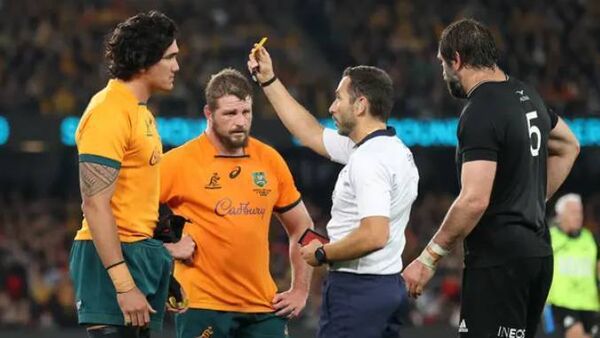Last week’s clash between Australia and New Zealand in the fifth round of the Rugby Championship produced no shortage of talking points. Nine tries, four yellow cards and of course, the controversial 80th minute decision to award the All Blacks a scrum five metres from the Australian line, allowing the Kiwis to snatch victory from their Oceanic rivals in the last play of the game.
For me, the most memorable moment – for all the wrong reasons – came on 35 minutes. To my surprise, it has been the subject of little discussion in the week since. Australian second-row Darcy Swain was yellow carded for what can only be described as a vicious, dangerous and contemptible clear out on All Black centre Quinn Tupaea.
If you haven’t seen it and you aren’t overly squeamish, you will find the incident easily on Twitter or YouTube by searching Swain’s name. Tupaea is locked into a poach position over the ball. He has won the battle and despite the efforts of two Australians, he can’t be moved. Swain then decides he has to get Tupaea off the ball, at any cost.
He enters the ruck from an illegal angle, almost perpendicular to the actual gate, and flings all his weight through his right shoulder in a downward motion to target the outside of Quinn’s left knee. The knee buckles inward in the way that makes you instinctively wince and look away. It’s one of those ones where you can vividly imagine the pain and potentially catastrophic consequences that will follow.
Despite the action being flagged by the TMO, Swain gets away with a yellow card and is back on the field ten minutes later. We subsequently learned that Quinn ruptured his medial cruciate ligament (on the inside of the knee) and partially tore his anterior cruciate ligament (the one everybody wants to avoid). He will miss a minimum of three months, but this could well be more than four, based on my own experience with a ruptured MCL.
There was immediate outrage that a red card was not shown but a general acceptance that a citing and lengthy ban would follow. The citing came; the lengthy ban did not. On Thursday we heard that Swain was given a six week suspension. It should have been at least twice that. Aside from being in the air to catch a high ball or lineout, being locked into a poach position with no visibility of what is around you is probably the most vulnerable position a player can find themselves in.
You are at the mercy of what the opposition do. You can’t protect your knees, ankles, ribs or neck. You can’t brace yourself for any impact that isn’t completely legal. And while incidents like Swain’s are rare, certainly at test level, it is evidence that there is still a lot more work to do to protect player welfare. I applaud World Rugby for the strides they have made in tackling the issue of concussion, by having a near zero-tolerance approach to contact with the head. The same attitude has to apply to dangerous play below the neck.
These episodes put a spotlight on the place of violence in rugby. I have had some interesting discussions about this with various people over the years and there is no black and white way to analyse it. Success in rugby, more than most sports, relies on a certain level of violence. In fact you could correctly argue that a player without some sort of violent streak is incapable of playing at a high level.
Blowing a threat off a ruck, creaming someone in a tackle and sitting someone on their arse when you carry the ball are all legal actions that require a degree of violence to be done well. As such, it’s safe to say there are both good and bad types of violence in rugby. The problem is the line between them is not always crystal clear.
Of course, headbutting (which Swain was also banned for in July), punching and eye gouging are clearly in the bad category. For something like this clearout, however, the lines are a bit more blurred. It is an action that starts from a legal place, clearing out being part and parcel of the game. Indeed, if he makes contact six inches higher on Quinn’s leg, the only offence he has committed is blatantly coming in the side.
Six inches is a fine margin but fine margins are everything in sport. This applies as much to dangerous play as it does to kicks at goal, lineouts, line breaks and everything else. Six inches in this case was the difference between Quinn finishing the game and being on the physio table for the next three or four months.
Fine margins apply to high tackles and contact with the head but that has not stopped aggressive efforts by rugby authorities to eliminate both from the game. It is finally starting to resonate with players that if you’re foolish enough go too high, there is a chance you will be given your marching orders a short time later. The thing is, the vast majority of head contacts or high tackles are not deliberate.
The same cannot be said for Swain, who knew exactly what he was doing. He wasn’t caught on the hop, having to react to a player running at him. He had a static target and had time to decide exactly where he was going to hit it. He was said to be ‘devastated’ to have injured Quinn after the game. I don’t doubt that but that is not a mitigating factor in any way.
I’m sure he didn’t set out to end Quinn’s tournament in that moment of madness, despite the recklessness of what he did. But he had a rush of blood to the head and decided to attack the most vulnerable joint in his opponent’s body – which he had no capacity to protect given his head was stuck in the ruck – with as much force as possible to get him off the ball.
There can be zero tolerance of deliberately reckless, dangerous actions that directly result in players suffering long-term injuries. Swain should have been given a much heftier ban and hopefully, this will act as a wake-up call to rugby lawmakers. Despite the progress that has been made, there clearly remains to make the sport a safer one, there is still a hell of a lot to do.

